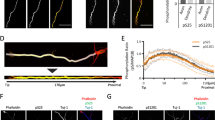Abstract
During experiments studying dietary effects on phosphorylation/dephosphorylation of MAP-2 we found that incubation of microtubules with alkaline phosphatase resulted in extensive proteolysis of MAP-2 but not of tubulin or Tau proteins. In the absence of tubulin, when microtubule-associated proteins (MAPs) were incubated with alkaline phosphatase, MAP-2 was not proteolyzed. This suggests that binding to tubulin induces a conformational change in MAP-2 which makes it more susceptible to proteolysis. The proteolysis of MAP-2 by alkaline phosphatase was prevented by inhibitors of serine proteases, suggesting that the commercial preparation of the enzyme is contaminated by a serine protease and/or that the enzyme also has a weaker proteolytic activity. In addition, selective proteolysis of MAP-2 can be obtained with the metalloprotease collagenase. Brain homogenates are shown to contain a Ca2+-dependent protease which selectively degrades MAP-2 bound to tubulin. These results suggest that selective proteolysis of tubulin-bound MAP-2 could play a role in the regulation of microtubule dynamics in response to extracellular signals.
Similar content being viewed by others
References
Harris, P. 1962. Some structural and functional aspects of the mitotic apparatus in sea urchin embryos. J. Cell. Biol. 14:475–487.
Matus, A. 1988. Microtubule-associated proteins: Their potential role in determining neuronal morphology. Annu. Rev. Neurosci. 11:29–44.
Yamada, K.M., Spooner, B. S., and Wessel M.W. 1970. Axon growth: role of microfilaments and microtubules. Proc. Natl. Acad. Sci. USA 66:1206–1212.
Schnapp, B. J., Vale, R., Sheetz, M.P., and Reese, T.S. 1985. Single microtubules from squid axoplasm support bidirectional movement of organelles. Cell 40:455–462.
Schroer, T. A. and Sheetz, M.P. 1991. Functions of microtubulebased motors. Annu. Rev. Physiol. 53:629–652.
Jameson, L. Frey, T., Zeeberg, B., Dalldorf, F. and Caplow, M. 1980. Inhibition of microtubule assembly by phosphorylation of microtubule-associated proteins. Biochemistry 19:2472–2479.
Brugg, B. and Matus, A. 1991. Phosphorylation determines the binding of microtubule-associated protein 2 (MAP2) to microtubules in living cells. J. Cell. Biol. 114:735–743.
Shelanski, M. L., Gaskin, F. and Cantor, C. R. 1973. Microtubule assembly in the absence of added nucleotides. Proc. Natl. Acad. Sci. USA 70:765–768.
Weingarten, M. D., Lockwood, A. H., Hwo, S. Y., and Kirschner, M. W. 1975. A protein factor essential for microtubule assembly. proc. Natl. Acad. Sci. USA 72:1858–1862.
Felipo, V., Miñana, M. D., Azorín, I., and Grisolía, S. 1988. Induction of rat brain tubulin following ammonium ingestion. J. Neurochem. 51: 1041–1045.
Sandoval, I. V., and Weber, K. 1978. Calcium-induced inactivation of microtubule formation in brain extracts. Eur. J. Biochem. 92:463–470.
Billger, M., Wallin, M. and Karlsson, J. O. 1988. Proteolysis of tubulin and microtubule-associated proteins 1 and 2 by calpain I and II. Difference in sensitivity of assembled and disassembled microtubules. Cell Calcium 9:33–44.
Johnson, G. V. M., Litersky, J. M. and Jope, R. S. 1991. Degradation of microtubule-associated protein 2 and brain spectrin by calpain: A comparative study. J. Neurochem. 56:1630–1638.
Fischer, I., Romano-Clarke, G. and Grynspan, F. 1991. Calpainmediated proteolysis of microtubule associated proteins MAP1B and MAP2 in developing brain. Neurochem. Res. 16:891–898.
Tsuyama, S., Bramblett, G. T., Huang, K. P. and Flavin, M. 1986. Calcium/phospholipid-dependent kinase recognizes sites in microtubule-associated protein 2 which are phosphorylated in living brain and are not accessible to other kinases. J. Biol. Chem. 261:4110–4116.
Kitagawa, K., Matsuomoto, M., Niinobe, M., Mikoshiba, K., Hata, R., Ueda, H., Handa, N., Fukuanaga, R., Isaka, Y., Kimura, K. and Kamada, T. 1989. Microtubule-associated protein 2 as a sensitive marker for cerebral ischemic damage. Immunohistochemical investigation of dendritic damage. Neuroscience 31:401–411.
Author information
Authors and Affiliations
Rights and permissions
About this article
Cite this article
Grau, E., Felipo, V., Miñana, MD. et al. The susceptibility of MAP-2 to proteolytic degradation increases when bound to tubulin. Neurochem Res 17, 967–971 (1992). https://doi.org/10.1007/BF00966822
Accepted:
Issue Date:
DOI: https://doi.org/10.1007/BF00966822




